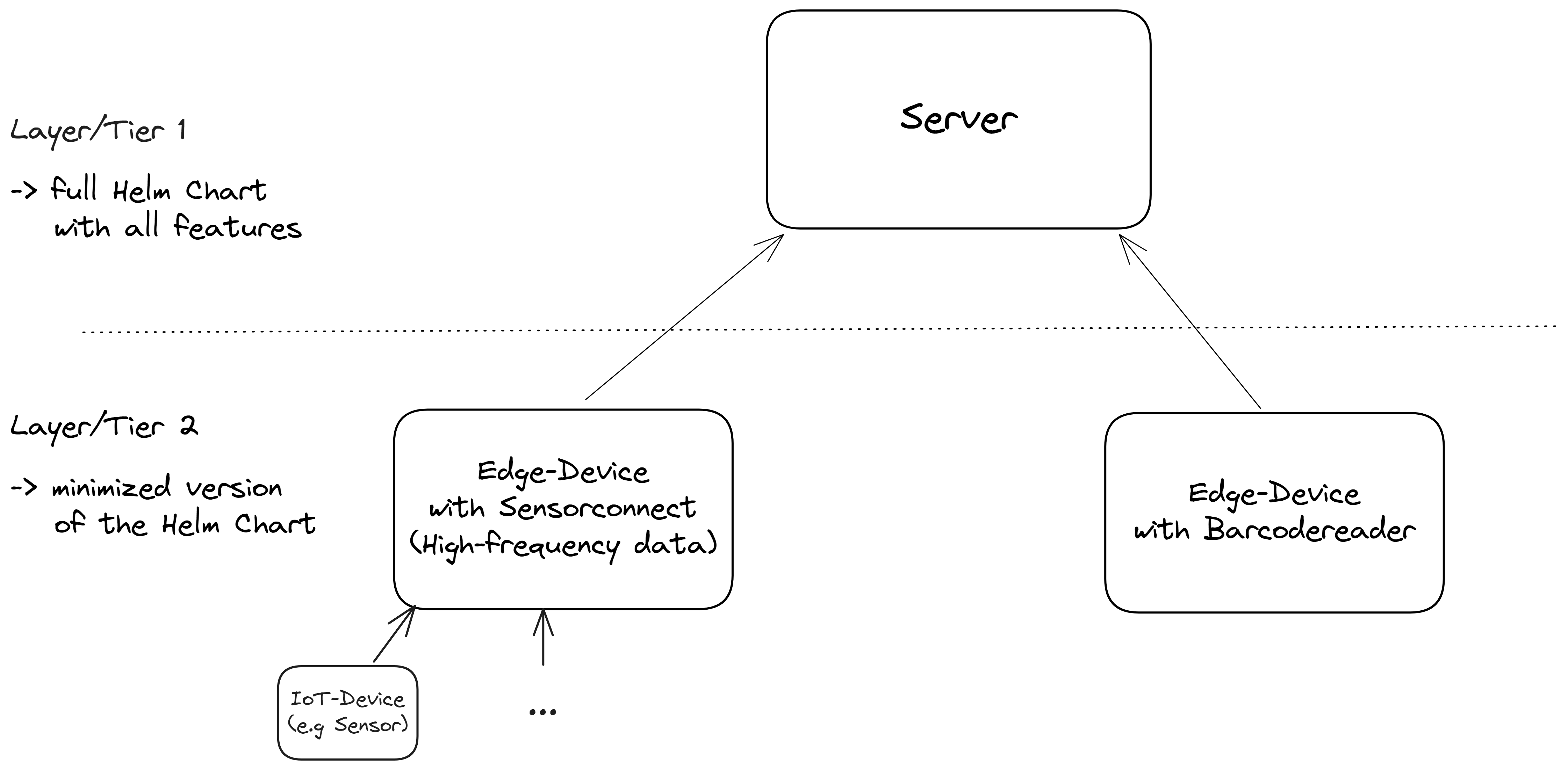Layered Scaling
4 minute read
Layered Scaling is an architectural approach in the United Manufacturing Hub that enables efficient scaling of your deployment across edge devices and servers. It is part of the Plant centric infrastructure , by dividing the processing workload across multiple layers or tiers, each with a specific set of responsibilities, Layered Scaling allows for better management of resources, improved performance, and easier deployment of software components. Layered Scaling follows the standard IoT infrastructure, by additionally connection a lot of IoT-devices typically via MQTT.
When should I use it?
Layered Scaling is ideal when:
- You need to process and exchange data close to the source for latency reasons and independence from internet and network outages. For example, if you are taking pictures locally, analyzing them using machine learning, and then scrapping the product if the quality is poor. In this case, you don’t want the machine to be idle if something happens in the network. Also, it would not be acceptable for a message to arrive a few hundred milliseconds later, as the process is quicker than that.
- High-frequency data might be useful to not send to the “higher” instance and store there. It can put unnecessary stress on those instances. You have an edge device that takes care of it. For example, you are taking and processing images (e.g., for quality reasons) or using an accelerometer and microphone for predictive maintenance reasons on the machine and do not want to send data streams with 20 kHz (20,000 times per second) to the next instance.
- Organizational reasons. For the OT person, it might be better to configure the data contextualization using Node-RED directly at the production machine. They could experiment with it, configure it without endangering other machines, and see immediate results (e.g., when they move the position of a sensor). If the instance is “somewhere in IT,” they may feel they do not have control over it anymore and that it is not their system.
What can I do with it?
With Layered Scaling in the United Manufacturing Hub, you can:
- Deploy minimized versions of the Helm Chart on edge devices, focusing on specific features required for that environment (e.g., without the Historian and Analytics features enabled, but with the IFM retrofitting feature using sensorconnect, with the barcodereader retrofit feature using barcodereader, or with the data connectivity via Node-RED feature enabled).
- Seamlessly communicate between edge devices, on-premise servers, and cloud instances using the kafka-bridge microservice, allowing data to be buffered in between in case the internet or network connection drops.
- Allow plant-overarching analysis / benchmarking, multi-plant kpis, connections to enterprise-IT, etc.. We typically recommend sending only data processed by our API factoryinsight.
How can I use it?
To implement Layered Scaling in the United Manufacturing Hub:
- Deploy a minimized version of the Helm Chart on edge devices, tailored to the specific features required for that environment. You can either install the whole version using flatcar and then disable functionalities you do not need, or use the Management Console. If the feature is not available in the Management Console, you could try asking nicely in the Discord and we will, can provide you with a token you can enter during the flatcar installation, so that your edge devices are pre-configured depending on your needs (incl. demilitarized zones, multiple networks, etc.)
- Deploy the full Helm Chart with all features enabled on a central instance, such as a server.
- Configure the Kafka Bridge microservice to transmit data from the edge devices to the central instance for further processing and analysis.
For MQTT connections, you can just connect external devices via MQTT, and it will land up in kafka directly. To connect on-premise servers with the cloud (plant-overarching architecture), you can use kafka-bridge or write service in benthos or Node-RED that regularly fetches data from factoryinsight and pushes it into your cloud instance.
What are the limitations?
- Be aware that each device increases the complexity over the entire system. We recommend using the Management Console to manage them centrally.
Because Kafka is used to reliably transmit messages from the edge devices to the server, and it struggles with devices repeatedly going offline and online again, ethernet connections should be used. Also, the total amount of edge devices should not “escalate”. If you have a lot of edge devices (e.g., you want to connect each PLC), we recommend connecting them via MQTT to an instance of the UMH instead.
Where to get more information?
- Learn more about the United Manufacturing Hub’s architecture by visiting our architecture page.
- For more information about the Helm Chart and how to deploy it, refer to the Helm Chart documentation.
- To get an overview of the microservices in the United Manufacturing Hub, check out the microservices documentation.
